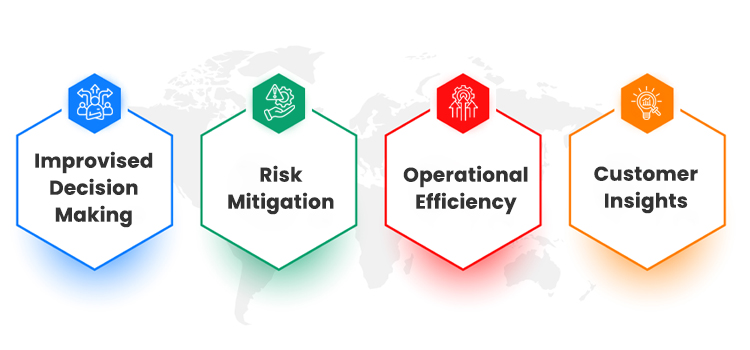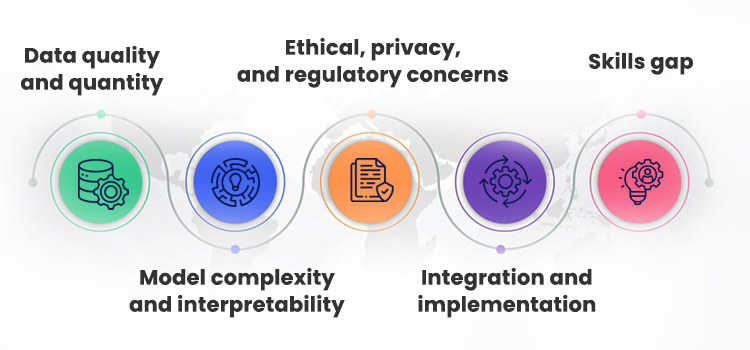What is Predictive Analytics?
Predictive Analytics works beyond usual data analytics methods by utilizing factual data, statistical algorithms, and machine learning techniques to predict future results. The highlight of predictive analytics is not understanding what already happens but predicting what will happen further. This feature is a highlight in making well-informed decisions rather than reactive responses.
Benefits of Predictive Analytics

Improvised Decision-Making:
It is easy for businesses to make data-driven decisions by predicting trends and behaviors that align with future scenarios.
Risk Mitigation:
Find out the potential risks and develop strategies to address them before they occur.
Operational Efficiency:
It helps to improve resource allocation, reduce waste, and increase operational processes.
Customer Insights:
Predictive analytics enables personalized marketing to improve customer experiences and increase retention.
How will Predictive Analytics help businesses succeed in 2025 and beyond?
Understanding Consumer Behavior:
Think you have a superpower to predict your customer’s next move is great right with the help of predictive analytics you can do that just like that. By identifying customer data, businesses can predict buying behavior, upcoming trends, and preferences. for example, a retail company can use predictive analytics to stock products based on anticipation of seasonal demand and reduce inventory costs while improving sales.
CODEFLIX is a global leader in technology consulting, with expertise in Business Workflow Automation, IoT, ServiceNow solutions, Artificial Intelligence, and digital transformation services. We integrate predictive analytics to improve customer targeting and personalize user experiences. this does not only elevate conversion rates but also improves brand loyalty ensuring clients view a measurable impact on their bottom line.
Improving Operational Efficiency
For SMEs generating handsome revenue, operational inefficiencies can affect resources. Predictive analytics helps to find areas for improvement by forecasting demand and optimizing supply chains. for instance, with the help of predictive models mid-size manufacturing companies can predict machine failures before they occur, schedule timely maintenance, and decrease downtime all these support cost savings and efficiency.
By utilizing Codeflix predictive analytics solutions, businesses can enhance their operations, reduce over-expenses, and improve resilience against market fluctuations.
Risk Management and Fraud Detection
Today’s Businesses face numerous risks ranging from financial, reputational, and operational risks. Predictive analytics plays an important role in finding out potential threats before they materialize. Let’s assume a financial institution that hires predictive models to detect anomalies in transaction data. this proactive approach ensures fraud prevention, safeguard assets, and maintain customer trust
With Codeflix’s advanced analytics capabilities businesses can strengthen their risk management frameworks and ensure solid protection against emerging threats.
Predictive Analytics Implementation - Step-by-step guide:
Define Your Objectives:
Before entering into data sets, you need to have a clear outline of what you aim to achieve with predictive analytics. Are you looking to improve sales, enhance customer service, or minimize the operation costs involved? Setting up proper goals will guide your strategy and help measure success.
Gather Quality Data:
The effectiveness of predictive analytics depends on the quality of data. spend on the data collection process that gives comprehensive accurate, and up-to-date information. from client interaction to supply chain logs- every data point could be essential.
Choose the Right Tools and Technologies
There are various tools and software available to support predictive analytics so picking the right one that suits your goals and runs smoothly with your current system is important. Codeflix offers bespoke analytics solutions designed to support businesses of all sizes—from SMEs to large enterprises ensuring easy integration and impactful outcomes.
Develop Predictive Models
Collaborate with data scientists or analytics experts to develop models tailored to your needs. These models should be flexible and adaptable, allowing for refinement as more data becomes available.
Interpret and Act on Insights
The last step involves turning insights into impactful strategies to support a data-driven culture and regularly refine your models to keep pace with shifting market trends.
Real-World Success Stories
Case Study 1: E-commerce Retailer Doubles Revenue
Problem:
An e-commerce retailer struggling with low customer interactions and didn’t have personalized marketing strategies in place This led to missed opportunities for increasing sales and keeping customer retention.
Solution:
The retailer teamed up with CODEFLIX to implement predictive analytics. By analyzing customers’ browsing behavior and purchase history, CODEFLIX helped the retailer to launch highly personalized marketing campaigns tailored to each individual’s preferences.
Outcome:
By implementing this, their customer conversion increased by 25%
Due to this, repeat purchases saw a 40% boost
The Annual Income of the retailer doubled due to enhanced customer engagement and loyalty.
Case Study 2: Codeflix Simplifies Support Ticketing
Problem:
An IT and consulting firm struggled with inefficiencies in its support ticketing system, with the team spending more time manually figuring out how to assign incoming support requests.
Solution:
CODEFLIX Collaborated with predictive analytics experts to regulate the ticketing process. Using machine learning, past support requests were analyzed and segregated based on urgency and type. The system seamlessly routed tickets to the Relevant support teams.
Outcome:
⏱️ Task handling time has significantly dropped by 98%, from one hour to under a minute
💼 Support teams focused more on fixing the problem than sorting them
⚡ Overall speed and quality of service delivery improved, resulting in higher customer satisfaction
Challenges of predictive analytics

Data quality and quantity:
The quality and quantity of data are essential for accurate predictions. Inaccurate or poor-quality data will lead to poor results.
Model complexity and interpretability:
Some of the AI Models are complex and difficult to understand unless they are made up keeping transparency in mind it is very difficult to understand how they arrive at certain predictions
Ethical, privacy, and regulatory concerns:
Predictive models can have ethical concerns, especially related to data privacy and algorithmic bias. They must also follow all relevant regulations. A small mistake can lead to a loss of trust.
Integration and implementation:
Adding predictive analytics into existing systems and workflow requires proper planning when you are handling legacy IT Infrastructure in that case compatibility and implementation can be challenging.
Skills gap:
There is a high demand for professionals with skill sets of predictive analytics and predictive AI, but it is difficult to attract and retain them.
Conclusion:
Predictive analytics is no longer a future concept; it has become an important business tool driving success in 2025 and beyond. it delivers incredible results by revealing consumer insights, streamlining operations, managing risks, and elevating customer experiences. Its impact is transformative. With the help of advanced models, high-quality data, and expert-led implementation, businesses can stay ahead of the competition, make informed decisions, and achieve measurable growth. At Codeflix, we empower organizations with predictive analytics solutions that not only solve today’s problems but also anticipate tomorrow’s opportunities.
